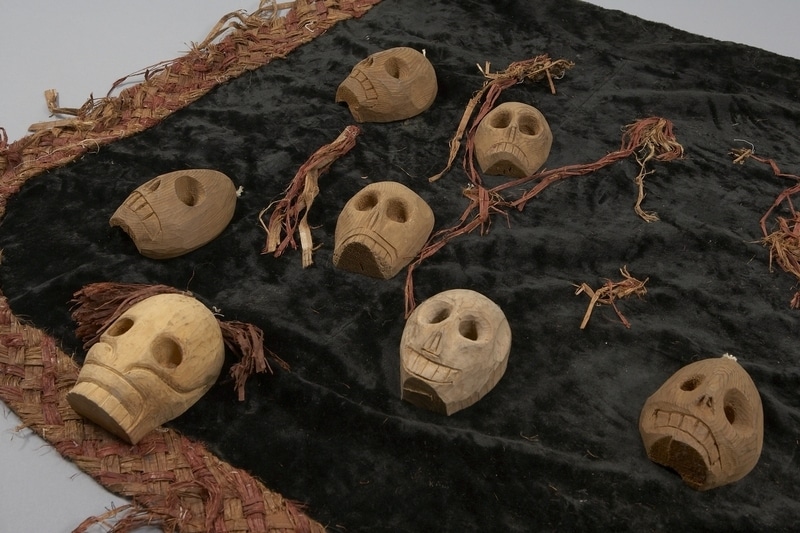Robe Item Number: A6080 from the MOA: University of British Columbia



Description
Rectangular black velvet robe with a border on three sides of diagonal checker work woven cedar bark. Eleven carved wooden skulls are tied on to the robe at intervals through small holes drilled in the top of the skulls. Clumps of shredded cedar bark are also attached.
History Of Use
During the period from November to March, the social organization of the Kwakwaka'wakw people was based on membership in the dancing societies rather than on clan affiliations. The most important and highest ranking dance of the winter was the Hamats!a society's. To become a fully fledged Hamats!a, an individual had to complete 4 years of dancing in each of 3 lower ranking dance societies. Each stage involved feasting, gifts, and ceremonial costs, requiring considerable wealth to complete. The Hamatsa performance is based in legends of bird-monsters who inhabited the sky-world, and were eaters of human flesh. The horror they inspired was heightened by the drama of the performance. The performance consisted of the seizure of the novice by the Hamatsa initiating spirit (bakbakwalanooksiwe), the novice's disappearance into the forest, his 4-day frenzy, and his ritual taming to the point where he became human again, and a fully-fledged member of the dancing society. On the final night there was feasting, recounting of the legend, and payment or gifts to all those who had taken part in the ceremonies.
Cultural Context
ceremonial
Iconographic Meaning
The skulls indicate the number of slaves or enemies killed to feed the hamats!a. See Boas, 1921, p. 1240; Mochon, 1966, pp. 91-94, Fig. 15.
"The small wooden skulls affixed to it are indicative of the number of times he has danced the Hamats!a. Skulls were the symbol of the Hamat!sa's grisley concern" (Hawthorn, 1967, pg. 129).
Item History
- Made in British Columbia, Canada before 1953
- Collected in Hopetown, British Columbia, Canada and Hegam's, British Columbia, Canada
- Owned by George Williams before June 16, 1953
- Received from H. R. MacMillan (Funding source) and George Williams (Seller) on June 16, 1953
What
- Name
- Robe
- Identification Number
- A6080
- Type of Item
- robe
- Material
- cotton fibre, wood and cedar bark
- Manufacturing Technique
- sewn, carved and woven
- Overall
- height 94.0 cm, width 155.0 cm
Who
- Culture
- Kwakwaka'wakw
- Previous Owner
- George Williams
- Received from
- H. R. MacMillan (Funding source) and George Williams (Seller)
Where
- Holding Institution
- MOA: University of British Columbia
- Made in
- British Columbia, Canada
- Collected in
- Hopetown, British Columbia, Canada and Hegam's, British Columbia, Canada
When
- Creation Date
- before 1953
- Ownership Date
- before June 16, 1953
- Acquisition Date
- on June 16, 1953
Other
- Item Classes
- textiles
- Condition
- fair
- Current Location
- Case 26
- Accession Number
- 1884/0001